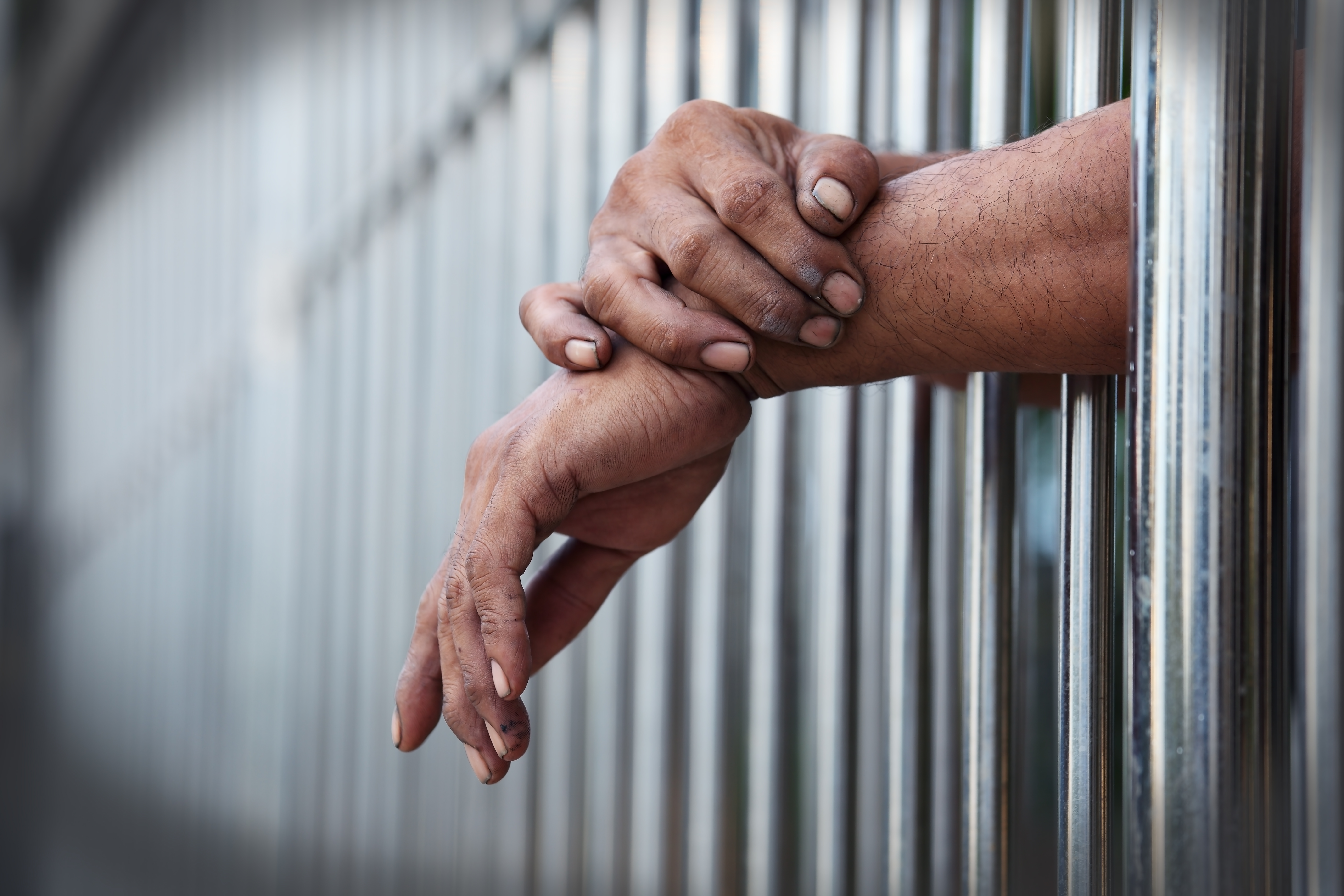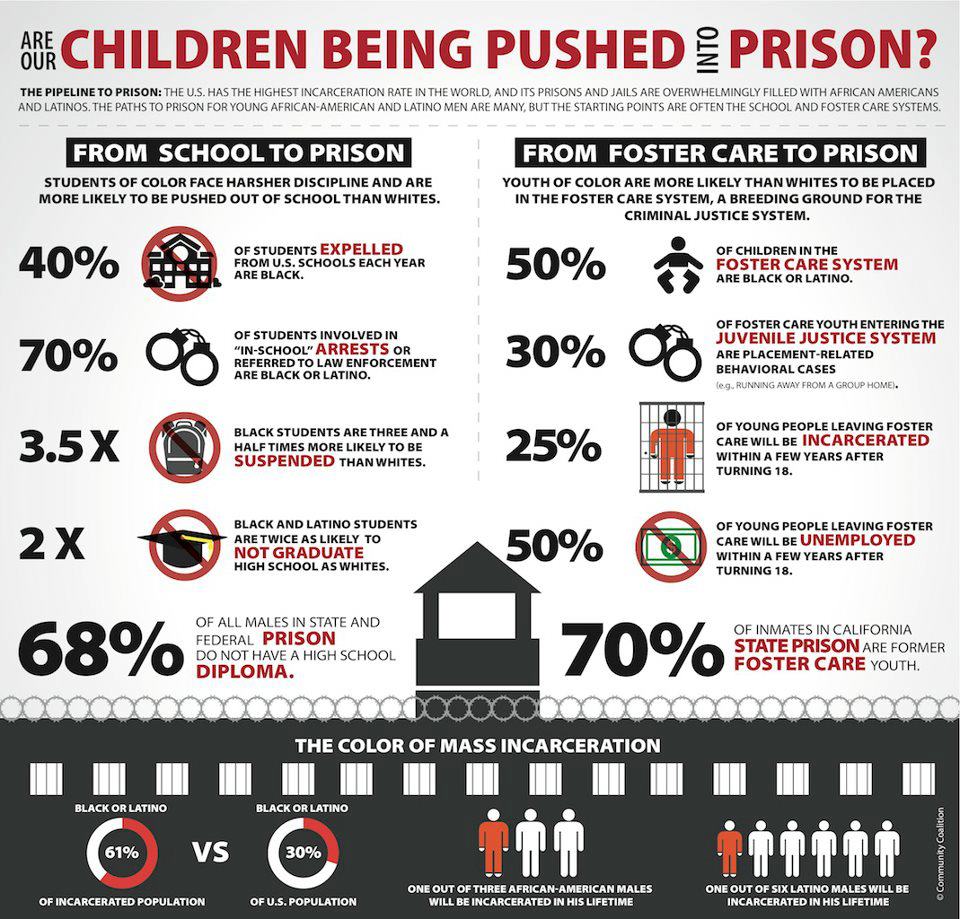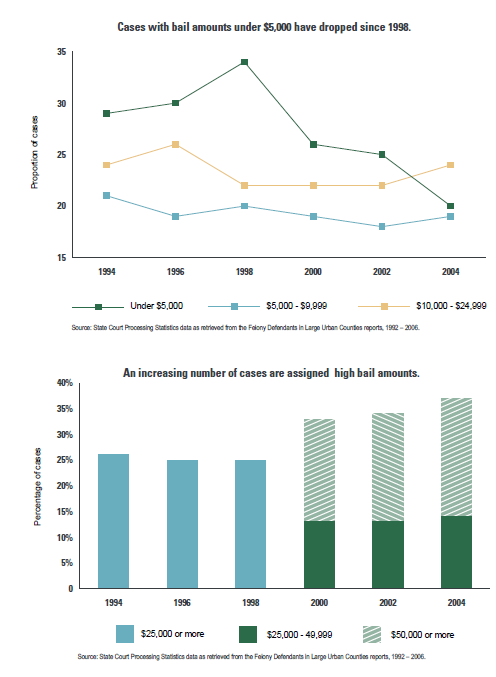Criminal Justice Reform

Many Latinos have reported an increase in racism and discrimination since 2016, when Donald J. Trump ran for president. Many Latinos will always remember Trump’s speech announcing that Mexicans are “Bringing drugs. They’re bringing crime. They’re rapists. And some, I assume, are good people”. Now more than ever it is important for Latinos to unite and fight for equality under the law. Unfortunately discrimination under the law is not a new phenomenon for Latinos. Latinos and African Americans are disproportionately represented in the prison industrial complex and have been greatly affected by mass incarceration. There are upwards of 56.6 million Latinos currently living in the United states, and of those Latinos:
- 56% of Latinos have had contact with the criminal justice system first hand or have a close family member that has
- 44% are more likely to be convicted than whites when convicted of property crimes
- 53% more likely to be convicted than whites for drug crimes
- In cases of robbery, aggravated assault, and simple assault were less likely to result in an arrest when Hispanics were the victims than when white non-Hispanics were the victims
- 31% live below the poverty line compared to 13.5% for the general population
- Have the highest high school dropout rates compared to Whites, Asians and blacks
- Less likely to be released on their own recognizance
- Only 33% were able to post bail when given the option
- Are more likely to have higher bail set
- There is no set standard to track ethnicities present in jails and prisons and therefore no way to calculate the full impact of mass incarceration on Latinos.This survey can be accessed here, and shows what data is collected by states on their jails and prisons. The Sentencing Project may also be accessed here to see incarceration rates for each state throughout the United States
The Pew Research Center released a report on Hispanics and the Criminal Justice System. This report outlines confidence in the legal system, confidence of equal treatment by police, and what that means for Latinos. This report can be accessed here.
LULAC’s Stance
The United States the highest incarceration rates of anywhere in the world. Within that system Latinos are approximately 30 percent of the nation's population but almost sixty percent of prisoners. This means that 1 in 6 male Latinos will be incarcerated at some point in their life. LULAC recognizes that Laws, policies, and practices throughout the criminal justice system, including racial profiling and disproportionate application of mandatory minimums, have resulted in African Americans and Latinos being much more likely to be stopped, arrested, and charged with crimes, as well as more likely to serve longer prison sentences for the same crimes as whites. National LULAC supports all efforts that prove to be effective to:
- reduce mass incarceration
- oppose racism
- reform practices that disproportionately impact communities of color
- create safe environments for all communities
- build trust between law enforcement and the communities they serve and protect
National LULAC works with the Department of Justice, national and local law enforcement organizations, civil rights groups, and communities to develop and promote community policing best practices-including expanded training and outreach programs to promote an inclusive, diverse and effective police force that better reflects the racial, ethnic, and religious communities it serves and protects. LULAC has also been working to dismantle the school-to-prison pipeline.
LULAC's resolution in support of criminal justice reform can be accessed here.
Latinos in the School-To-Prison Pipeline
The school to prison pipeline is a phenomenon in which harsh school discipline policies that include suspensions and expulsions often lead students to drop out of school and ultimately become entangled in the criminal justice system. Schools often enforce race-neutral zero-tolerance policies for all of their students. Despite the race-neutral language used in these policies the U.S. Department of Education reports that 70% of students who fall victims to the school-to-prison pipeline, either by arrests or referrals to law enforcement agencies, have been Latinos. Latinos enter the school-to-prison pipeline at higher rates than their white counterparts. This is detrimental to the advancement of Latino education in the United States. Consequences for entering the school to prison pipeline include:
- Over a third of Latinos fail high school
- Despite the decrease in dropout percentages in recent years, Latinos continue to have the highest dropout rates
- Less than 13% of the Latino population hold advanced degrees
An article explaining the role of bias in the school-to-prison pipeline can be accessed here.
Sage Journals published an article titled: "The Right to Be Literate: Literacy, Education, and the School-to-Prison Pipeline" that discusses Latino youth in the school-to-prison pipeline. This article can be accessed here.

This image was taken from the PBS "Fact Sheet: How Bad Is the School-to-Prison Pipeline?" By Carla Amurao
Why does this matter?
These harsh school policies leave Latino youth without a high school diploma and with a criminal record. A criminal record prevents an individual from achieving important opportunities such as jobs, financial aid for college/university, and public housing. It is problematic that such a high percentage of Latino youth are affected by the school-to-prison pipeline. Getting involved with your school board and speaking out against the criminalization of our youth can help roll back these harmful policies.
Criminalization of Immigration
The Obama administration had some of the highest rates of deportations in recent decades but the criminalization of immigration has been on the rise for many years. Policies that focused on simple removal of the country for immigrants has transitioned into making simply being in the United States illegally a crime. Laws such as the Criminal Alien Assistance Funds have made it profitable for private prison corporations to arrest and detain illegal immigrants.
Prisons that arrest and detain illegal immigrants receive compensation “for incarcerating undocumented criminal aliens with at least one felony or two misdemeanor convictions for violations of state or local law”. The 2016 SCAAP award details show that the state of California alone received $50,600,084.00 and the state of New York received $13,535,207.00 under the Criminal Alien Assistance Funds.The full report of grant awards given by the Bureau of Justice Assistance U.S. Department of Justice can be accessed here.
Why does this matter?
Expedited removals of immigrants means that many immigrants will not have a chance to speak to a judge before their removal to plead their case. Expedited removals also mean that families will be separated without much notice. Placing a focus on charging and removing immigrants instead of simply removing them from the country makes it impossible for an immigrant to ever enter legally into the United States or to apply for papers in later years. This is particularly harmful for mixed status families, who have illegal parents but United States citizen children. Deporting the parents will mean these children will end up in foster homes or be taken to a country they have never been in.
Bail

This image was taken from the Justice Policy Institute's publication on "Bail Fail: Why the U.S. Should End the Practice of Using Money for Bail"
Mass incarceration has disproportionately affected African Americans and Latinos in the United States.The United States has the highest rates of incarceration in the World. Of those incarcerated in the United States, 1 in 3 are African American men and 1 in 6 are Latino men compared to 1 in 17 white men. The disproportionate representation of Latinos and African Americans in jail is detrimental for minority progress in the United States. It is crucial that the system aids minorities entering into the criminal justice system. The full report on Criminal Justice Facts can be accessed here.
Bail greatly affects Latino's ability to operate within the criminal justice system. Bail is set at significantly higher rates for Latinos compared to those of Whites or Asians. And Latinos are less likely to be released on their own recognizance. Rates of bail have been shown to be set at higher rates for Latinos specifically but have also increased overall by $30,000. As a result, of the Latinos that are given the option to post bail, only 33% are able to afford it. Bail that is posted is forfeited by the defendant regardless of what the conviction may be. This means that if someone is wrongly arrested, they may lose $10,000+ to be released from jail and begin preparations for their court trial. It has also been shown that defendants who are held pretrial are more likely to be convicted of a felony. There is no set system for determining bail across the United States, and therefore is just an arbitrary amount set regardless of a person's financial means. Being held pretrial increases the costs for each defendant. These costs include but are not limited to days of work lost, childcare costs, and strain on family life. These costs along with the desire to avoid dangerous or harmful conditions in jail can lead a defendant to plead guilty in an effort to reduce the cost of being detained even if they are innocent. A study in 2012 found that 50% of defendants that plead guilty were innocent so that they received a lower sentence.
Prior arrests are often used to help determine if a detainee will be released on their own recognizance, but this does not take into consideration if those arrests led to a conviction, why the arrest was made, or how long ago the arrest happened. A full article on the impact of prior arrests on plea bargaining can be accessed here.
As of 2013, Latinos made up 22% of the prison population nationwide wide but only represent 17% of the population compared to Whites who are 77% of the population but only make up 32% of the prison population.The United States jails run on a 91% capacity, and of that 91%, 60% consists of defendants being held until their court hearing.
The Justice Policy Institute published great information in their article "Bail Fail: Why the U.S. should end the practice of using money for bail".

These charts were taken from the Justice Policy Institute's publication on "Bail Fail: Why the U.S. Should End the Practice of Using Money for Bail"
Why Does Bail Matter?
An arrest can cause a person to lose wages, lose their job, fail a class, or even leave vulnerable family members uncared for. Defendants can spend months in prison waiting their trial to begin. These defendants are less prepared for their court cases than defendants who are released on their own recognizance. The mental strain of being in jail makes defendants more vulnerable to accepting plea deals, that are not in their best interest. Most Latinos who are caught in the criminal justice system cannot afford proper representation and must rely on overworked public defenders to try their cases.
Current Policies
Criminalization of Immigration:
The targeting of sanctuary cities by the current administration is very harmful to the immigrants present in the United States. Executive order 13768 grants local law enforcement the authority to act as immigration officials in order to expedite the removal of illegal immigrants. It also requires that all counties notify Department of Homeland Security when an illegal immigrant has been arrested, and hold the detainee for 48 hours or until a removal hearing can be arranged. Holding the detainee negatively affects immigrant’s due process rights and only 14% of detainees are able to acquire legal representation. Judges have already made rulings on this executive order and have decalred that Executive Order 13768 was executive overreach. Many of these cities have also had raids that have ended in 500 arrests, not all of which consisted of immigrants with a criminal background.
Executive Oder 13768
- All counties must report all illegal immigrants with any chargable criminal offense regardless of conviction or not
- Grants the power to immigration officers to report an illegal alien if the officer finds the immigrant to pose a threat to public safety or national security
- Calls for an additional hiring of 10,000 immigration officers
- Empowers state and local law enforcement agencies across the country to perform the functions of an immigration officer in the interior of the United States to the maximum extent permitted by law
Criminal Justice Reform:
On October 4, 2017 the Senate introduced S.1917: Sentencing Reform and Corrections Act of 2017. This bill is a bipartisan effort to create necessary criminal justice reform. This proposed bill:
- Reduces minimum sentencing for three strikes law from a life sentence to 25 years
- Minimum sentencing is reduced for a person who commits a drug violation with a prior conviction for a felony drug offense. The 20 year minimum sentence is reduced to a 15 year minimum sentence. This may be applied retroactively (To cases which have already closed and have applied the 20 year minimum sentence. Cases will be evaluated and if applicable, time will be reduced)
- Made the Fair Sentencing Act of 2010 that reduced the disparity in sentencing between crack and powder cocaine applicable retroactively
- In order to better understand and reduce recidivism (The rates in which a convicted criminal re-offends and goes back to jail) this bill calls for a report to "develop a risk and needs assessment system that will determine the recidivism risk of all federal inmates and classify inmates as having a high, moderate, or low risk of recidivism"
The House of Representatives Judiciary Committee's page on their Criminal Justice Reform Initiative can be accessed here.
